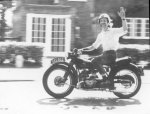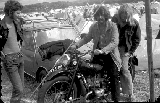The bike was shipped to Vermont in 1980, when I moved
here. I ran it every summer (wet snow plays havock with the
exposed ignition system) until 1991 when my priorities seemed to
change. After about ten years of sitting in my basement, it seemed
like time to get to work and get it going. I did steadily get some
work done on the front forks, general paintwork clean up, steering head,
wheel bearings, clutch thrustbearing, etc etc. I was out of
action for a few weeks in the summer of 2003 while my magneto was being
rewound by Dave Lindsley in Heywood, Lancs. I should have known it was
failing, but I was in denial until both cylinders just cut one day. Now
it's amazing - starts 1st kick, and idles OK at traffic lights! I don't
like riding on fast highways with a top speed of 65 mph being as fast as
I like to go, with no reserve of power. But Vermont back roads are
probably much like UK in the 1950's, so it just feels right those days.
I love to ride the Mark, when it's running well, but I just seem to
spend more time working on it than riding, and I never have 100%
confidence I'm going to get home again. Upgrades like modern oil seals,
etc. help. The original design had optional air filters, and a
simple gauze strainer in the sump for the oil. I suppose that's asking
for trouble. I rebuilt the crankshaft a few years ago, after the
infamous blocked crankshaft oil channels disaster. I built a jig to
press the thing apart, and together, and got some parts (including
rollers) from John Ramsey in Preston, UK.
Note that this bike is not quite original - especially the dual seat,
exhaust system is Mark V not Mark III
|
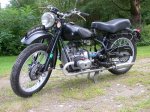
Figure 2: Left view 2003
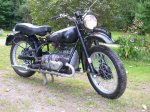
Figure 3: Right view 2003
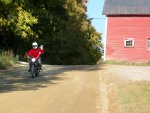
Figure 4: Joy ride
|
